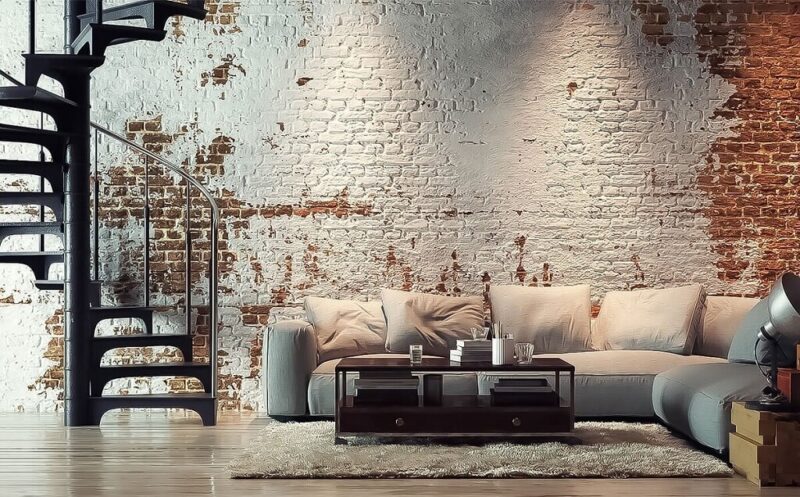Industrial interior design is about embracing the raw, honest beauty of materials and spaces. It captures the character of old factories and warehouses while making them feel inviting and livable.
This style prioritizes functionality, turning elements like exposed bricks, steel beams, and distressed wood into design features that tell a story.
Each piece, whether a vintage find or a modern creation, adds to the space’s personality. With its balance of practicality and bold aesthetics, industrial design transforms ordinary rooms into striking, meaningful spaces.
The following elements will guide you in creating an authentic industrial look that feels real and personal.
1. Modern-Rustic Fusion
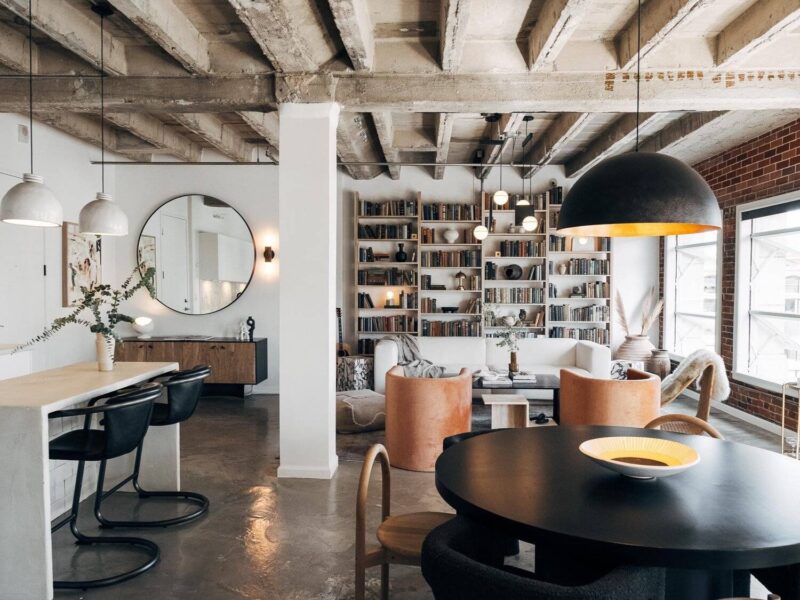
Modern elements paired with rustic touches create the foundation of industrial interiors. The style blends clean finishes with raw materials, offering bold and timeless character.
Key Materials
- Wood: Weathered wood brings warmth to tables, cabinets, and accents.
- Metal: Steel and iron enhance furniture, lighting, and decor.
- Concrete: Polished concrete works well for floors, countertops, or decorative elements.
Thin Bricks for Texture
Thin bricks deliver the charm of aged brick walls without structural work. Use them to create a feature wall, highlight shelving areas, or frame an entryway. They are an ideal solution for achieving an industrial feel while keeping it practical.
Focus on Balance
Use a few standout pieces to define the room. A brick wall combined with a steel-frame table or reclaimed wood shelving ensures the design stays cohesive. Avoid overfilling spaces to maintain clarity and purpose.
2. Vintage Pieces
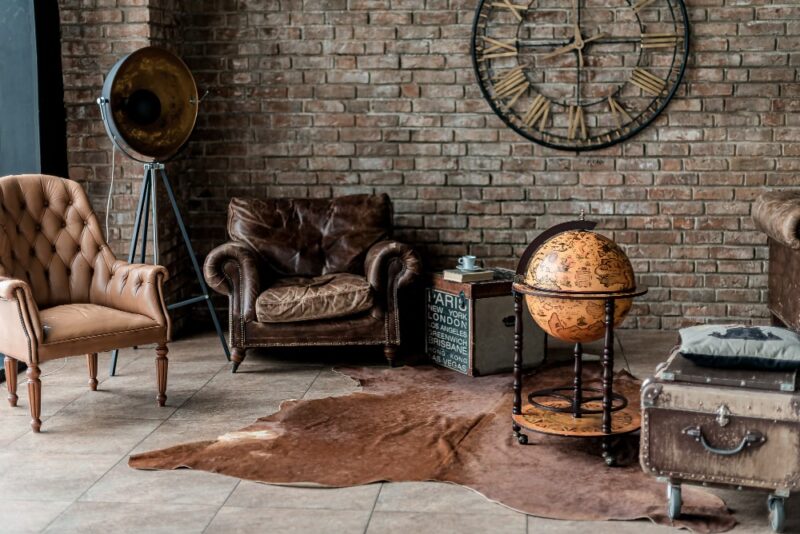
Choose furniture that shows its age. A distressed leather armchair or a reclaimed wood dining table with visible imperfections works beautifully. These pieces reflect authenticity and create a lived-in look that defines industrial interiors.
For smaller touches, consider items like antique side tables, retro bar stools, or a weathered storage chest. These items add layers of detail without overpowering the room.
Practical and Stylish
While vintage items are decorative, they also serve functional purposes. A refurbished metal locker can double as storage, and an antique ladder can display throws or magazines. These dual-purpose elements fit the industrial focus on practicality.
Example Layout
Picture a living room where a worn leather sofa sits opposite a reclaimed wood coffee table. A vintage metal fan rests on an old storage trunk in one corner, while a salvaged factory pendant light illuminates the space. Each item tells a story, making the room unique and engaging.
3. Metal Accents

Select pieces like steel-frame coffee tables, iron shelving units, or bar stools with metal bases. These items balance form and function, delivering the industrial aesthetic without overwhelming the space. For subtle touches, look for furniture with exposed metal legs or accents.
Decorative Uses of Metal
Metal decor enhances the style further. Wall-mounted shelves with iron brackets, vintage metal toolboxes repurposed for storage, or metallic light fixtures all add visual interest. Sculptural items like wrought iron candlesticks or galvanized trays can complete the look.
Example Application
A dining area with a reclaimed wood table paired with steel-framed chairs offers the perfect blend of industrial materials.
Overhead, a brushed metal pendant light adds ambiance while tying the space together.
4. Exposed Features
Highlight features like exposed brick walls, visible ductwork, or steel beams. These elements create texture and bring depth to the room. Even imperfections, such as weathered concrete or chipped paint, contribute to the character.
Modern Applications
In kitchens, open shelving with exposed brackets replaces traditional cabinets. In living spaces, visible piping can be painted black or left in its original finish to serve as a design feature.
5. Neutral and Metallic Colors

The color palette of industrial interiors focuses on subtle tones that highlight materials and textures. These colors bring cohesion to the design and ensure the space feels both grounded and sophisticated.
- Neutral Tones: Shades of white, beige, and grey provide the foundation for walls and larger surfaces.
- Metallic Shades: Incorporate accents of silver, bronze, or copper through furniture, lighting, or decor.
- Earthy Hues: Use muted greens, browns, or brick-red tones to add warmth without overpowering the space.
In open layouts, neutral walls create a backdrop that allows focal points like a copper pendant light or a distressed metal chair to stand out. Combine darker hues with lighter tones to maintain balance and avoid a heavy feel.
6. Distressed Wood
Distressed wood adds warmth and texture to industrial interiors. Its imperfections—knots, scratches, and uneven finishes—tell a story, aligning perfectly with the raw aesthetic of the style.
Furniture and Flooring
Reclaimed wood tables, benches, and shelving units are staples of this design. For flooring, choose wide planks with a weathered look to enhance the rustic feel.
Smaller Touches
Incorporate wooden picture frames, trays, or planter boxes to introduce warmth in smaller doses. Even a simple wooden ladder leaned against a wall can serve as a functional and decorative element.
Combined Materials
Pair distressed wood with metal for a classic industrial look. For example, a wooden tabletop with iron legs or shelving with metal brackets creates a cohesive blend of textures.
7. Open Layouts
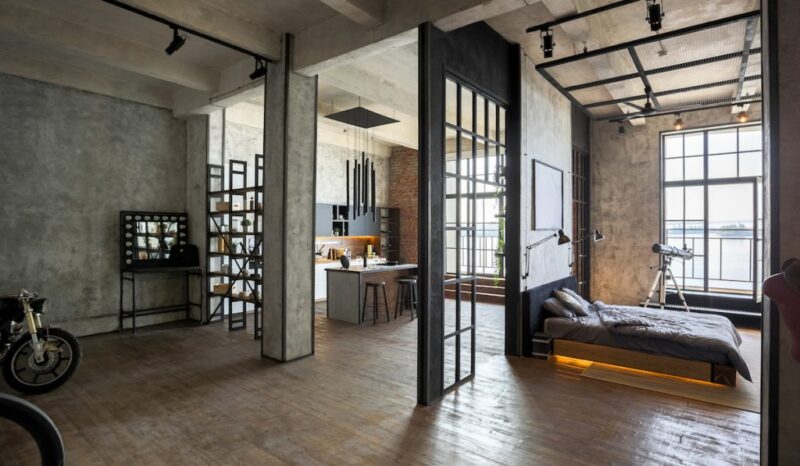
Tear down unnecessary walls to connect living areas, kitchens, and dining spaces. The goal is to create a natural flow between spaces, allowing light to travel freely. If complete openness is not possible, use dividers like glass panels or sliding doors to maintain the effect.
Use furniture to outline areas instead of walls. For example:
- Place a large sofa to mark the edge of a living space.
- Use a dining table to separate a kitchen from the rest of the room.
8. Raw Materials
Raw materials embody the industrial aesthetic. These elements give the space authenticity, emphasizing strength and practicality.
- Concrete: Polished for floors or left raw for walls.
- Steel and Iron: Visible beams, furniture frames, or even staircases.
- Brick: Exposed in its natural state or sealed for durability.
A kitchen with concrete countertops paired with steel stools reflects this approach. In living spaces, a brick accent wall and iron light fixtures create visual depth. Use these materials sparingly in small spaces to avoid overpowering the design.
9. Warm Lighting
Lighting sets the mood in industrial interiors. Warm tones soften the harshness of raw materials, creating a welcoming environment.
Types of Fixtures
- Pendant Lights: Metal or glass pendants add a factory-inspired look.
- Edison Bulbs: Their soft glow is ideal for accenting key areas.
- Task Lighting: Adjustable lamps for desks or reading corners.
Focus lighting on functional areas like dining tables or workspaces. Layer light sources by combining overhead fixtures with wall sconces or floor lamps. Keep cables visible when possible for an authentic feel.
Example
A dining area lit by copper pendant lights above a reclaimed wood table feels both industrial and inviting. Use dimmers to adjust light levels based on the mood you want to create.
10. Minimalist Decor
Industrial interiors thrive on simplicity. Minimalist decor ensures that each element has a purpose, leaving spaces uncluttered and visually striking.
Fewer Pieces, More Impact
Avoid overcrowding rooms with unnecessary items. Select a few meaningful pieces, such as a metal-framed mirror, a vintage chair, or a concrete planter. These elements stand out more when surrounded by open space.
Focus on items that serve both decorative and practical purposes. Examples include:
- A steel shelving unit for books and decor.
- A reclaimed wood bench for seating and storage.
- A simple pendant light that doubles as a statement piece.
11. Detailed Craftsmanship
The small details in industrial interiors make a big difference. Visible craftsmanship—welded seams, exposed screws, and hand-finished wood—adds authenticity to the design.
Features to Look For
- Visible Joinery: Tables with dovetail joints or shelving with raw brackets.
- Handcrafted Touches: Lamps with custom metalwork or handmade ceramic decor.
- Wear and Tear: Scratches, dents, and other imperfections that reflect use over time.
Choose furniture and decor that reveals its making. A clock showing its gears, a bench with riveted legs, or a cabinet with welded edges adds character to the space. Each detail tells a story, making the room feel more personal.
12. Functional Simplicity
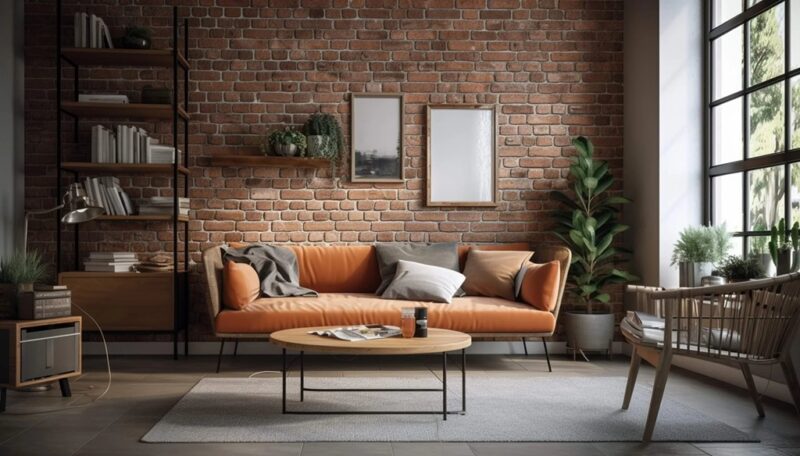
Industrial interiors prioritize function over excess. Every item in the space serves a purpose, making the design both efficient and visually cohesive.
- A metal cart that doubles as a kitchen island.
- A leather sofa with built-in storage compartments.
- A bed frame with under-bed storage.
Avoid Overcomplication
Stick to clean lines and straightforward designs. A simple dining table paired with metal chairs or a basic shelving unit creates a timeless look. Unnecessary embellishments detract from the practicality of the space.
Create Harmony
Let functional pieces dictate the layout. A sofa placed near a brick wall, or a workbench doubling as a desk, ties the room together naturally. Every element should contribute to the overall purpose of the room.
FAQs
What Are Common Industrial Flooring Options?
Industrial interiors often feature flooring options that highlight raw materials and durability. Polished concrete is a popular choice for its smooth surface and modern appeal. Hardwood with a distressed finish or even epoxy-coated floors can also fit the style while offering practical benefits.
Can I Use Fabric in Industrial Interiors?
Yes, fabric can soften the hard edges of industrial design. Consider using natural materials like linen or canvas for curtains, cushions, or throws. Stick to muted or earthy tones to maintain cohesion with the overall aesthetic.
Are Plants Suitable for Industrial Interiors?
Plants can bring life and contrast to industrial interiors. Opt for hardy varieties like succulents, snake plants, or pothos, which thrive in minimalistic settings. Use metal planters or concrete pots to stay true to the theme.
How Can I Add Personality Without Cluttering the Space?
Incorporate personal touches like framed artwork, vintage finds, or books. Keep these elements minimal and intentional, allowing each piece to stand out. Rotating decor seasonally can also refresh the look without overwhelming the space.
What Type of Rugs Work Best in Industrial Spaces?
Flat-woven rugs in neutral colors or geometric patterns work well in industrial interiors. Look for materials like jute, sisal, or wool that add texture without overpowering the raw materials and clean lines of the design.
Last Words
Industrial interior design combines functionality and raw aesthetics to create spaces that feel authentic and purposeful. It emphasizes natural materials, thoughtful details, and a balance between old and new.
Each element serves a role, whether it is a vintage centerpiece, raw structural feature, or a simple, minimalist addition.
Hello, my name is James Willett. I am a marketing veteran, with decades of experience under my belt. At one point, I decided to share my experience with others, especially those who are making baby steps in marketing. Therefore, I decided to join fine folks at PulseBluePrint.com where I share my insights on all sorts of marketing. I hope you will find my insights useful.

